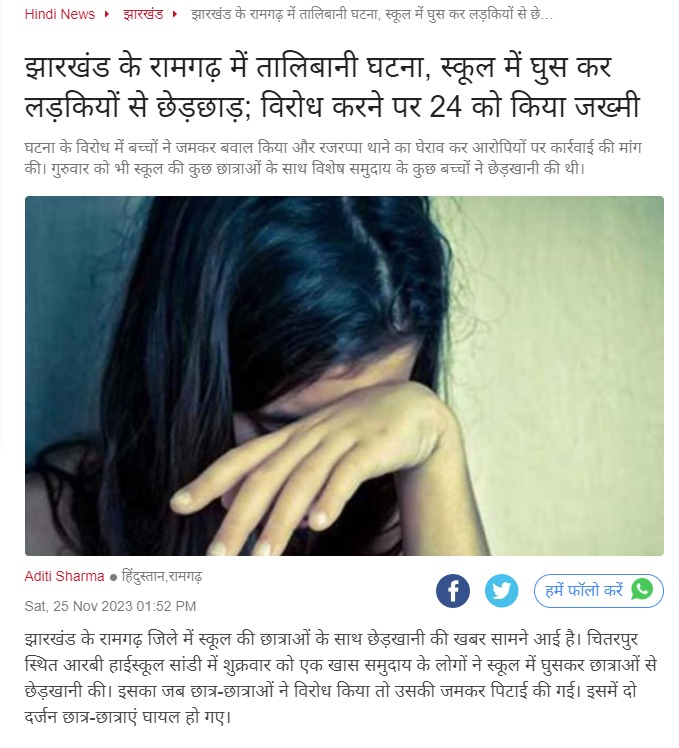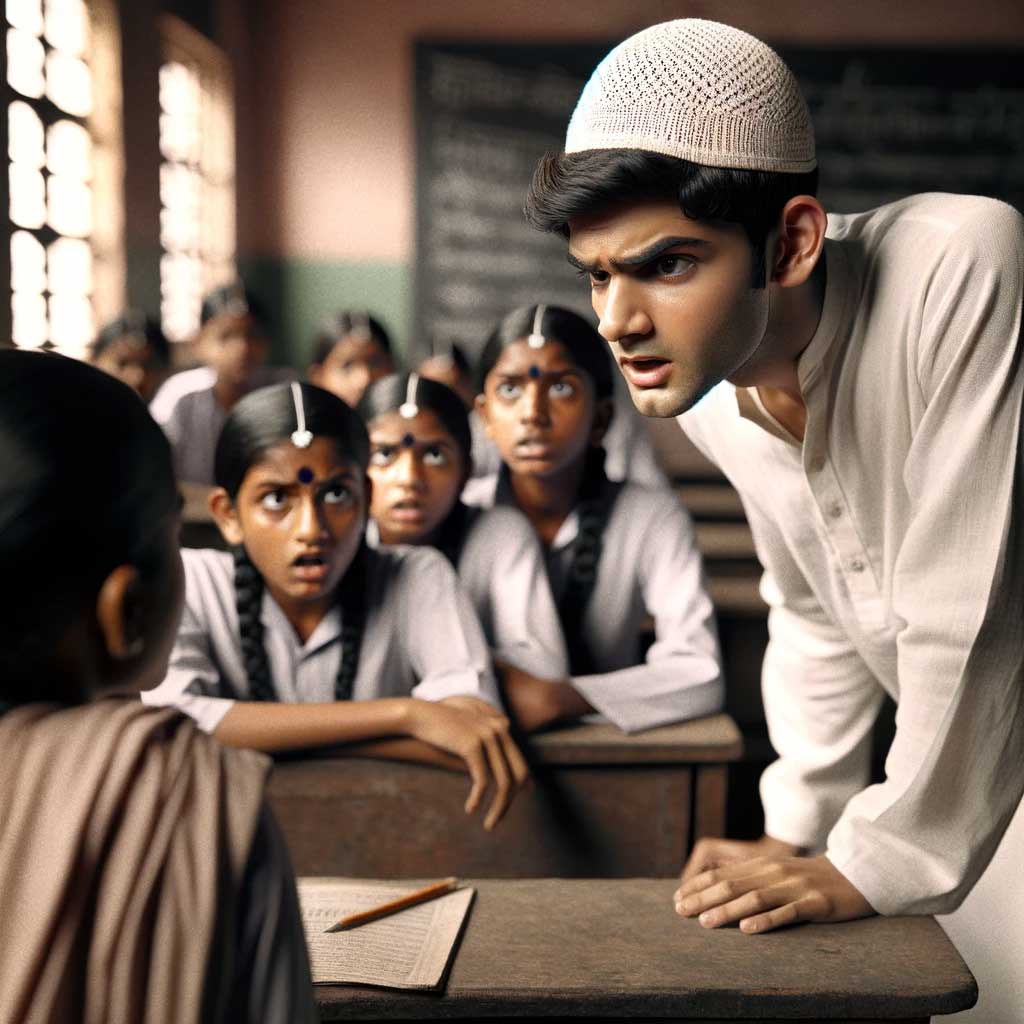MORE COVERAGE
Twitter Coverage
JOIN SATYAAGRAH SOCIAL MEDIA
"Unity defies intimidation": In Jharkhand, Farhan, Rehan, Danish, Arshad, Abuzar & Javed led a mob into a school, assaulting Hindu girls and coercing them to chant 'Islam Zindabad', a complaint was filed at Rajrappa police station against them and others

In a deeply troubling incident in Jharkhand’s Ramgarh, a group of individuals, identified as Farhan, Rehan, and Javed, among others, reportedly stormed into a school, creating a scenario of fear and chaos. This act of aggression, targeted at Hindu girls, is a stark reminder of the religious and social tensions that can flare up in communities, raising serious questions about communal harmony and safety in educational institutions.
|
The incident, which occurred on Friday, 24th November, involved the girls being accosted while returning from school. They were reportedly surrounded by Muslim youths who then forced them to chant "Islam Zindabad". This demand, deeply intrusive and frightening in its nature, reflects a blatant disregard for the girls' religious beliefs and personal autonomy. When the students resisted, the situation escalated violently, with the perpetrators reportedly attacking them with sticks. The gravity of this confrontation cannot be overstated, as it signifies a brutal infringement on the rights and safety of these young students.
Tragically, around 24 individuals, including both the girl students and boys who courageously attempted to intervene, sustained injuries in the ensuing melee. The injured were promptly taken to the Ramgarh Civil Hospital, highlighting the severity of the encounter and the physical toll it took on those involved. The response of medical personnel and the community in providing immediate care to the victims is a small yet significant beacon of hope and humanity in the midst of such a harrowing event.
A formal complaint was lodged at the Rajrappa police station, implicating Mohammed Farhan, Mohammed Rehan, Mohammed Javed, and several others, including Mohammed Danish, Mohammed Arshad, Mohammed Zishan, Mohammed Abuzar, and Mohammed Sahil. The mention of these specific individuals, along with other unnamed accomplices, suggests a targeted and premeditated act, which raises concerns about the underlying motivations and the broader implications for community relations in Ramgarh.
|
This incident is not just a reflection of individual criminal behavior but also an unsettling reminder of the challenges faced in ensuring safety and harmony in diverse communities. It underscores the urgent need for dialogue, education, and proactive measures to bridge communal divides and foster an environment of mutual respect and understanding. The attack on these students is an affront to the values of tolerance and coexistence, calling for introspection and action from all segments of society.
The incident, which has shaken the community of Ramgarh, took place in the RB High School, located in the Sandi area of Chitarpur. This location, a place meant for learning and growth, became the backdrop for a distressing episode of violence and molestation. The accused, a group of Muslim youths, forcefully entered the school premises, blatantly disregarding the sanctity of this educational space. Their actions, described as molestation of female students, represent a severe breach of the safety and security that every educational institution is obligated to provide.
What is particularly alarming is the reported recurrence of such behavior. It's noted that on Thursday, a day prior to the major incident, some students had already faced molestation at the hands of these same individuals. This prelude to the larger attack raises critical questions about the response mechanisms in place at the school and the broader community's approach to such threats. The repetition of these acts indicates a disturbing pattern of behavior that was not adequately addressed after the initial occurrence.
|
On Friday, this situation escalated when these molesters, accompanied by other local goons, stormed the school. Their actions were not limited to molestation but also included physical assault on those who tried to intervene. The use of the term "brutally beaten" to describe the treatment of the students who resisted, both girls and boys, paints a harrowing picture of the violence that ensued. The fact that two dozen individuals were injured in this attack is a stark testament to the severity and the chaotic nature of the assault.
In the aftermath of this violence, the aggrieved students took their grievances to the police station, their actions indicative of a community pushed to its limits by fear and frustration. The scene at the police station, described as a ruckus, speaks volumes about the emotional turmoil and desperation for justice among the students and their supporters. Station House Officer H N Singh's assurance of action against the culprits is a crucial step in addressing this incident. However, this promise of action must be followed by swift and effective measures to ensure justice and restore a sense of safety and normalcy in the school and the wider community.
This incident at RB High School is not just an isolated act of violence but a symptom of deeper societal issues that need to be addressed. It underscores the importance of creating safe spaces for students, instilling values of respect and tolerance, and implementing robust systems to prevent and respond to such acts of aggression and violation. The community of Ramgarh, the school authorities, law enforcement, and all stakeholders must come together to ensure that such incidents are not repeated and that schools remain sanctuaries of learning and personal development.
Piyush Pandey, the District Superintendent of Police, addressed the gravity of the situation with a statement that underscores the seriousness with which the authorities are treating this incident. He said, “The case of assault on girl students by entering the school has come to the notice. It is under examination. Something can be said only after investigation.” This comment reflects a commitment to a thorough and fair investigation, highlighting the complexity of the situation and the need for a detailed examination of the facts before drawing any conclusions.
 |
The allegations made by the students in the school add another layer of distress to this already troubling scenario. They claim that the attackers not only physically assaulted them but also attempted to impose their religious beliefs by forcing the victims to chant “Islam Zindabad”. This alleged act of coercion, involving a threat to the students' right to education if they did not comply, is particularly alarming. It signifies not just a physical violation but also a psychological and ideological imposition, further complicating the dynamics of this incident.
The response of the police, as they launch a search for the accused, is a crucial step in addressing this situation and ensuring accountability. The treatment of all injured students at the Ramgarh Civil Hospital demonstrates the immediate and tangible impact of the attack, necessitating medical intervention and care.
SDPO Kishore Rajak's statement, “It is too early to say anything, we are looking into the matter, and action will be taken against the guilty,” aligns with the cautious approach taken by law enforcement. This statement indicates a recognition of the need for a comprehensive and careful investigation to ensure that justice is served appropriately and that any punitive measures are firmly grounded in the findings of a thorough inquiry.
The report that school principal Manoj Mitra’s mobile phone was found switched off adds a note of unavailability or potential unresponsiveness from the school's leadership at a critical time. This detail, while seemingly minor, raises questions about the school's immediate response and its role in the aftermath of the incident. It also underscores the importance of effective communication and leadership in crisis situations, especially in educational institutions.
The situation in Ramgarh, as described by the students receiving treatment in the hospital, sheds light on a deeply concerning pattern of behavior that seems to have been occurring over a period of time. Their statements that "the local Muslim youths regularly molested the female students of this school" suggest a recurring issue of harassment and violation that had not been sufficiently addressed. This ongoing nature of the problem points to systemic issues in ensuring the safety and security of students, particularly the female students at this school.
The reference to a "similar incident of molestation" that occurred on Thursday, which led to a minor altercation, indicates that the attack on Friday was not an isolated event but rather part of a troubling series of incidents. The students' claim that the Muslim community members and their parents could not "digest" the altercation and thus orchestrated Friday's attack suggests a complex and deeply rooted communal tension within the community. This aspect of the incident highlights the need for not only law enforcement intervention but also community-based solutions to address underlying issues of intolerance and misunderstanding.
|
The response of Jharkhand state BJP president Babulal Marandi, who expressed his condemnation of the incident on a social media platform X, formerly known as Twitter, brings the incident into the political arena. His call for clarification from the government signifies a demand for accountability and a higher level of scrutiny from state authorities. Marandi's involvement underscores the potential for this incident to spark broader political and social discourse, reflecting the need for leadership in addressing not only the immediate concerns but also the larger implications for communal harmony and the safety of educational institutions.
Babulal Marandi, the Jharkhand state BJP president, shared a tweet that vividly captures his perspective on the disturbing events at RV High School in the Chhatarpur block under Rajrappa police station, Ramgarh district. He described the incident as “the systematic teasing of school girls by Muslim boys and stone pelting on the girls after they protested the molestation today at RV High School,” highlighting the seriousness and the apparently targeted nature of the attack. Marandi’s depiction of these actions as “systematic” suggests a pattern of behavior that extends beyond a single event, implying a recurring issue that demands immediate attention.
His rhetorical questions — “What is the fault of the girls? Only that they are Hindus?” — are charged with emotion and imply a communal angle to the assault. These questions serve to emphasize the vulnerability and innocence of the victims, while also pointing to a potential religious motivation behind the attacks. Such framing of the issue can be seen as an attempt to draw attention to the communal tensions that may underlie the incident.
Marandi’s critique extends to the state government led by Hemant Soren, accusing it of “supporting cruelty and criminals under the guise of religion.” This statement is politically loaded, suggesting that the state government’s policies or attitudes may be contributing to a climate in which such incidents can occur. It reflects a common tactic in political discourse where an incident is used to question or challenge the ruling government’s effectiveness or intentions.
His final remarks, “Girls are now feeling unsafe even in going to school. The government should clarify what kind of Jharkhand it wants to create,” point to a broader concern about the safety and security of girls in educational institutions. The emphasis on the girls’ growing sense of insecurity is a call to action, urging the government to take concrete steps to ensure the safety of students and to articulate its vision for the state’s future, particularly regarding communal harmony and the protection of vulnerable groups.
Marandi’s tweet, especially when considered in the context of his political position, can be seen as a call for greater accountability from the state government and a demand for immediate action to address the issues of safety, communal tension, and the protection of the rights of minority groups. It also reflects the complex interplay of politics, religion, and social issues in the region, underscoring the need for a multifaceted approach to address such deeply entrenched challenges.
 |
 Support Us
Support Us
Satyagraha was born from the heart of our land, with an undying aim to unveil the true essence of Bharat. It seeks to illuminate the hidden tales of our valiant freedom fighters and the rich chronicles that haven't yet sung their complete melody in the mainstream.
While platforms like NDTV and 'The Wire' effortlessly garner funds under the banner of safeguarding democracy, we at Satyagraha walk a different path. Our strength and resonance come from you. In this journey to weave a stronger Bharat, every little contribution amplifies our voice. Let's come together, contribute as you can, and champion the true spirit of our nation.
 |  |  |
| ICICI Bank of Satyaagrah | Razorpay Bank of Satyaagrah | PayPal Bank of Satyaagrah - For International Payments |
If all above doesn't work, then try the LINK below:
Please share the article on other platforms
DISCLAIMER: The author is solely responsible for the views expressed in this article. The author carries the responsibility for citing and/or licensing of images utilized within the text. The website also frequently uses non-commercial images for representational purposes only in line with the article. We are not responsible for the authenticity of such images. If some images have a copyright issue, we request the person/entity to contact us at This email address is being protected from spambots. You need JavaScript enabled to view it. and we will take the necessary actions to resolve the issue.
Related Articles
- Hindus documented massacres for 1000s of years: Incomplete but indicative History of Attacks on India from 636 AD
- In a major breakthrough, Police have recovered IEDs smuggled across the border to Pakistan backed terrorist sleeper cells, linked to Dawood Ibrahim’s terror module: a number of explosives have also made their way into Gujarat via the water route
- Afghan MMA fighter Abdul Badakshi along with mob of Afghan supporters attempts to murder an Indian fighter Srikant Sekhar in Delhi, happened after Seth Rosario won fight from Badakshi upsetting his supporters, Badakshi has a fake Aadhar and dual passport
- Imam Usman apparently discovered his wife Hina is pregnant with a girl based on his ‘tantra’ education, throws her off the roof of the mosque, and tried to blame murder on ‘7-headed Kali’: Saharanpur
- Radical Mohammedans chopped off Dilbar Negi's limbs and burnt him alive, the Islamic mob torched properties of Hindus till 24th Feb night: Fresh charge sheet against 12 in Delhi riots
- Manyavar commercial featuring Alia Bhatt vilifies Hindu wedding ritual Kanyadaan: Why not object Western practice of ‘giving away the bride’ and Nikah (marriage contract)
- Sanãtana Dharma Versus Prophetic Creeds - Defence of Hindu Society
- Aparna Yadav whose husband Prateek was accepted as legitimate son of Mulayam Singh Yadav when CBI inquiry on his income reached Supreme Court now joins BJP: The love affair of the SP patriarch that the Yadav family would rather not talk about
- Moplah Genocide of the Malabar Hindus, 1921: Thousands of Hindus slaughtered
- Ajmer 1992 rape case: Whole Bharat was shocked when influential caretaker family of sacred shrine Khwaja Chishti initiated forced sexual exploitation en masse by Farooq Chishti, a scandal that involved hundreds of girls raped and harassed daily
















